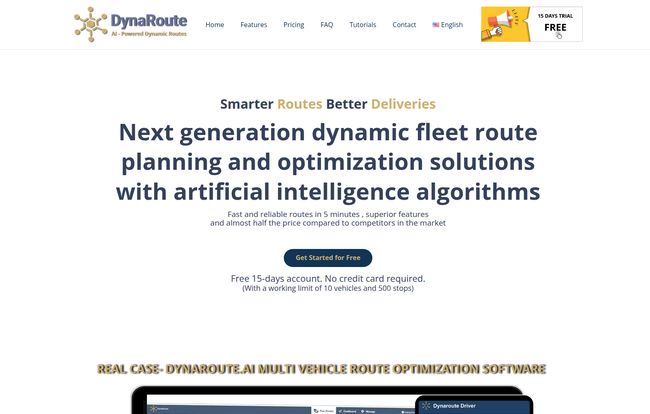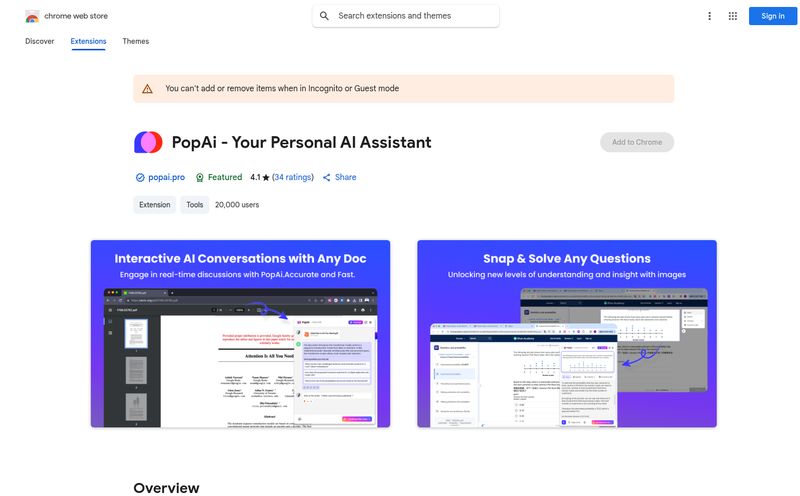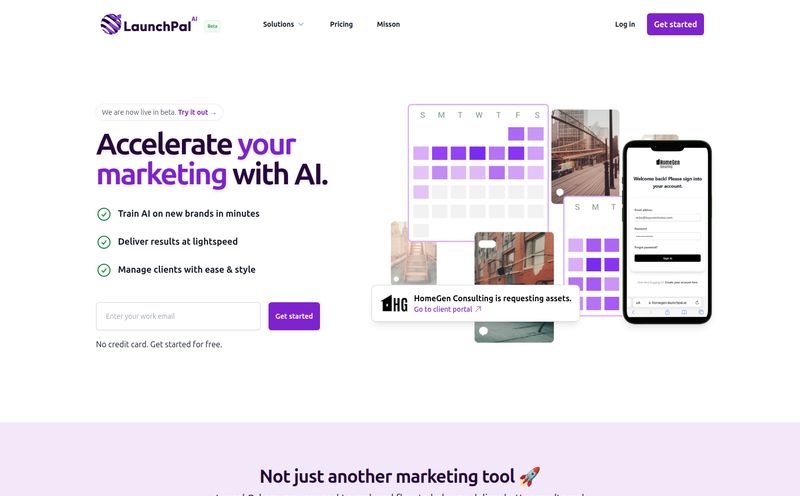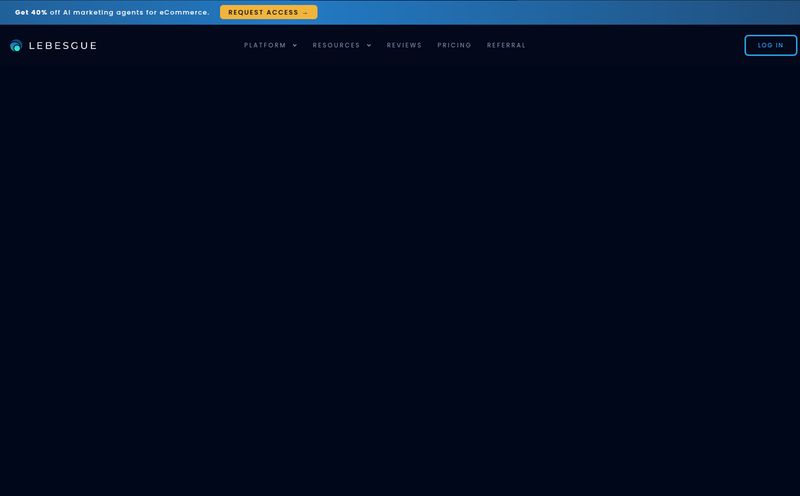If you’re in any business that involves moving things or people from point A to a whole bunch of other points, you know the daily chaos. It’s a beautiful, maddening puzzle. You've got rising fuel prices staring you down, drivers who are worth their weight in gold, and customers who expect Amazon-level precision. Juggling all that with a spreadsheet and a wall map? Good luck. You’re bringing a spork to a sword fight.
I’ve been in the traffic-generation game for years, and a lot of that is about efficiency. Getting the most clicks for the least spend. The same logic applies to a fleet of vans. How do you get the most deliveries for the least time and fuel? That’s the million-dollar question, isn’t it?
So when I stumble across a tool like Dynaroute, which claims to be a “next generation dynamic fleet route optimization” platform, my inner skeptic raises an eyebrow. We’ve heard these promises before. But this one’s powered by AI, and that’s where things get interesting. Is it just another piece of tech promising the world, or is it the real deal? I had to find out.
So What Exactly is Dynaroute Anyway?
Strip away the marketing jargon, and Dynaroute is essentially a super-intelligent brain for your logistics operations. You feed it all your stops, your vehicle information (how much can it carry? does it have a freezer?), and any weird constraints like customer delivery windows or a driver who’s only trained for specific tasks. Then, instead of just finding the shortest path like Google Maps, its AI engine crunches all those variables to spit out the most efficient plan.
Think of it like a chess grandmaster for your delivery fleet. While you're thinking one move ahead, it's already calculated the next ten, factoring in traffic patterns, load weights, and priority stops. It’s designed to stop you from sending a half-empty truck across town twice when one fully-loaded, perfectly-planned trip would have done the job. It’s about working smarter, not just driving harder.

Visit DynaRoute
First Impressions and Getting Started
The website promises you can “Optimize Your Route in 3 Min.” and I have to admit, I rolled my eyes. I've seen too many software platforms with a learning curve steeper than Everest. But the interface is surprisingly clean. It's built for people who have a job to do, not for tech enthusiasts who love clicking through a million menus.
They offer a 15-day free trial, which is my favorite price. You can get a feel for the system without whipping out the company card. The trial has its limits, of course—10 vehicles and 500 stops—but it's more than enough to see the magic happen on a small scale and decide if it’s a good fit for your operation.
The Features That Actually Move the Needle
A long list of features can be overwhelming. Let’s cut through the noise and talk about the bits that I think make a tangible difference to a business’s bottom line.
The AI-Powered Optimization is the Real MVP
This is the heart of Dynaroute. The fact that it considers things like vehicle capacity, delivery time windows, driver skills, and even package size/weight is what sets it apart from basic planners. It performs what’s called multi-objective optimization. It’s not just solving for the shortest distance, it’s solving for the lowest cost, which is a far more complex and valuable calculation. This is how you reduce those dreaded empty miles and increase your vehicle fill-ups. It's a game of inches, and this AI is designed to win them all for you.
Dynamic Planning and Real-Time Tracking
Here’s a scenario: a customer calls to cancel their delivery mid-day. Or a major accident shuts down a highway. With a static, paper-based plan, you’re scrambling. Your driver is calling you, you're trying to re-route on the fly... it's a mess. Dynaroute’s dynamic planning means the system can adjust. The plan can be updated in real-time and pushed to the driver's mobile app. Honestly, the peace of mind from this feature alone is incredible. The included real-time tracking also slashes the number of “Where’s my delivery?” calls from customers, freeing up your support staff to do... well, anything else.
Beyond the Route: Integrations and Proof of Delivery
For any established business, a new piece of software has to play nice with the existing tools. Dynaroute gets this. Their ability to integrate with ERP and CRM platforms is a huge plus. This means it can pull order data directly from your main system, eliminating a ton of manual data entry and potential for error. Then there's the Proof of Delivery (POD) feature. Drivers can capture signatures or photos right on their mobile app. No more lost paperwork or disputes about whether a package was delivered. It’s professional, it’s clean, and it protects your business.
Okay, But How Does It Actually Save Me Money?
This is the bottom line, right? Features are nice, but results pay the bills. The money-saving aspect comes from a few key areas:
- Reduced Fuel Costs: This is the most obvious one. Smarter, shorter routes mean less fuel burned. With gas prices being what they are, this can add up to thousands of dollars a year for a decent-sized fleet.
- Improved Labor Efficiency: When routes are optimized, your drivers can complete more stops in the same amount of time. This either means you can grow your business without adding more drivers, or you can reduce overtime pay. Both are huge wins.
- Better Asset Utilization: The system helps ensure your trucks are as full as possible. Fewer, fuller trips are always cheaper than more, half-empty ones. You might even find you can serve your entire customer base with fewer vehicles, which is a massive capital expense saving.
And let's not forget the softer benefits. Less stress for your dispatchers. Happier drivers who aren't backtracking all day. A better reputation with customers who get reliable delivery windows. These things might not show up on a spreadsheet immediately, but they absolutely contribute to a healthier buisness in the long run.
Let's Talk Numbers: Dynaroute Pricing
Alright, the investment. I was pleasantly surprised that the pricing is pretty straightforward. It's a per-vehicle, per-month subscription model. This is smart because it scales with your business.
| Plan | Price per Vehicle | Billing Cycle |
|---|---|---|
| Monthly | $29 / month | Billed Monthly |
| Annually | $25 / month | Billed Annually (Save 10%) |
Pricing is based on information available at the time of writing. Always check the official Dynaroute pricing page for the most current details.
At first glance, $29 per vehicle might seem like just another monthly bill. But you have to frame it as an investment. If the software saves a single driver just two hours of work a month, or a few gallons of fuel per week, it has already paid for itself. For most fleets, the return on investment should be pretty obvious and pretty quick.
The Catch: Are There Any Downsides?
No tool is perfect. It's important to be upfront about the potential drawbacks.
The main one is the cost itself. While I believe the ROI is there, it's still a subscription fee. For a brand new business or a solopreneur just starting out, that monthly expense is a real consideration. This software is clearly aimed at established businesses with multiple vehicles where the efficiencies can be multiplied.
The other point is the limitation on the free trial. It's great for a test drive, but you can't run your whole business on it for free. That’s fair, but it means you have to make a decision after those 15 days are up. There's a commitment involved.
Frequently Asked Questions About Dynaroute
I get these questions a lot, so let's just tackle them head-on.
- How does Dynaroute actually work?
- In short, you give it your list of jobs, vehicle details, and rules (like time windows). Its AI algorithm then runs millions of calculations to find the optimal combination of routes that minimizes cost and time while respecting all your rules.
- Is there really a free trial?
- Yep, a 15-day free trial. No credit card required to get started. It's limited to 10 vehicles and 500 stops, but it's perfect for seeing if the platform works for you.
- Can I change my plan or cancel easily?
- From what I see on their site, yes. They mention being able to upgrade or downgrade mid-term. Most modern SaaS companies make this process pretty painless, as they'd rather keep you as a customer on a different plan than lose you entirely.
- Is it difficult to set up and use?
- The company claims an easy user interface, and from my initial look, I'd agree. It seems designed for dispatchers and managers, not IT experts. Of course, integrating it with an ERP system will take a bit more work, but that's to be expected.
- Will it work with the systems I already use?
- It's designed to! Dynaroute offers integration with many top ERP, CRM, and Telematics platforms. This is one of its stronger selling points for established businesses looking to slot it into their existing tech stack.
Final Thoughts: Is Dynaroute the Right Route for You?
After spending some time with it, I'm genuinely impressed. Dynaroute isn't just another GPS. It's a strategic tool. It’s for businesses that have moved past the point of just “getting it done” and are now focused on “getting it done in the smartest, most profitable way possible.”
If you're running a single van for your flower shop, this might be overkill. But if you have a fleet of two, five, ten, or a hundred vehicles on the road every day? Then I'd argue you're losing money by not using a tool like this. The compounding savings in fuel, labor, and time are just too significant to ignore.
It’s an investment, for sure. But in a world of tight margins and high customer expectations, investing in efficiency is one of the smartest moves you can make. Dynaroute looks like a very, very smart move indeed.



